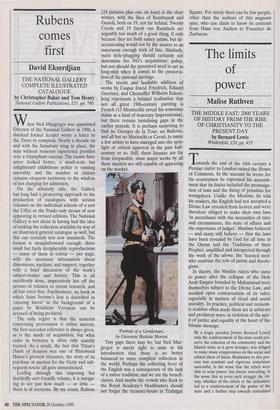Rubens comes first
David Ekserdjian
THE NATIONAL GALLERY COMPLETE ILLUSTRATED CATALOGUE by Christopher Baker and Tom Henry National Gallery Publications, £35, pp. 790 When Neil Macgregor was appointed Director of the National Gallery in 1986, a shocked former keeper wrote a letter to the Times to complain. Nearly a decade on and with the Sainsbury wing in place, the man without museum experience presides over a triumphant success. The rooms have never looked better, a small-scale but enlightened exhibitions policy is running smoothly, and the number of visitors remains eloquent testimony to the wisdom of not charging for admission.
On the scholarly side, the Gallery has long had a pioneering approach to the production of catalogues, with serious volumes on the individual schools of a sort the Uffizi or the Prado only dream of now appearing in revised editions. The National Gallery is not alone in having had the idea of making the collection available by way of an illustrated general catalogue as well, but this one certainly sets new standards. The format is straightforward enough: three small but fairly decipherable reproductions — many of them in colour — per page, with the necessary information about dimensions, medium, and support, together with a brief discussion of the work's subject-matter and history. This is all excellently done, impressively hot off the presses in relation to recent research, and all but error free. Furthermore, no book in which Saint Jerome's lion is described as `creating havoc' in the background of a panel by Bonifazio Veronese can be accused of being po-faced.
The only regret is that the material concerning provenance is rather uneven; the first recorded reference is always given, as is the mode of acquisition, but what came in between is often only scantily treated. As a result, the fact that Titian's Death of Actaeon was one of Harewood House's greatest treasures, the story of its purchase at auction for the Getty and sub- sequent rescue all goes unmentioned.
Leafing through this imposing but decidedly user-friendly volume, it is intrigu- ing to see just how much — or little there is of everyone. By my count, Rubens (24 pictures plus one on loan) is the clear winner, with the likes of Rembrandt and Guardi, both on 19, not far behind. Twenty Corots and 19 Jacob van Ruisdaels are arguably too much of a good thing, if only because they are both samey artists, but de- accessioning would not be the answer to an innocuous enough trick of fate. Similarly, mere hole-plugging should certainly not determine the NG's acquisitions' policy, but nor should the perceived need to act as long-stop when it comes to the preserva- tion of the national heritage.
The recent and laudable addition of works by Caspar David Friedrich, Eduard Gaertner, and Christoffer Wilhelm Eckers- berg represents a belated realisation that not all great 19th-century painting is French (13 Monticellis reveal his sometime status as a kind of honorary Impressionist), but there remain tantalising gaps in the earlier periods. It is perhaps surprising to find no Georges de la Tour, no Bellotto, and all but no Marieschi or Ceruti, to name a few artists to have emerged into the spot. light of critical approval in the past hall- century or so. Still, these lacunae are far from irreparable, since major works by all these masters are still capable of appearing on the market.
'Portrait of a Gentleman, by Giovanni Battista Moroni Tiny gaps there may be, but Neil Mac- gregor is surely right to state in his introduction that there is no better balanced or more complete collection in the world. Perhaps the collecting fever of the English was a consequence of the lack of a native tradition, and we are the benefi- ciaries. And maybe the crowds who flock to the Royal Academy's blockbusters should not forget the treasure-house in Trafalgar Square. For surely there can be few people, other than the authors of this magnum opus, who can claim to know its contents from Hans von Aachen to Francisco de Zurbaran.


































































 Previous page
Previous page